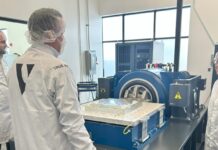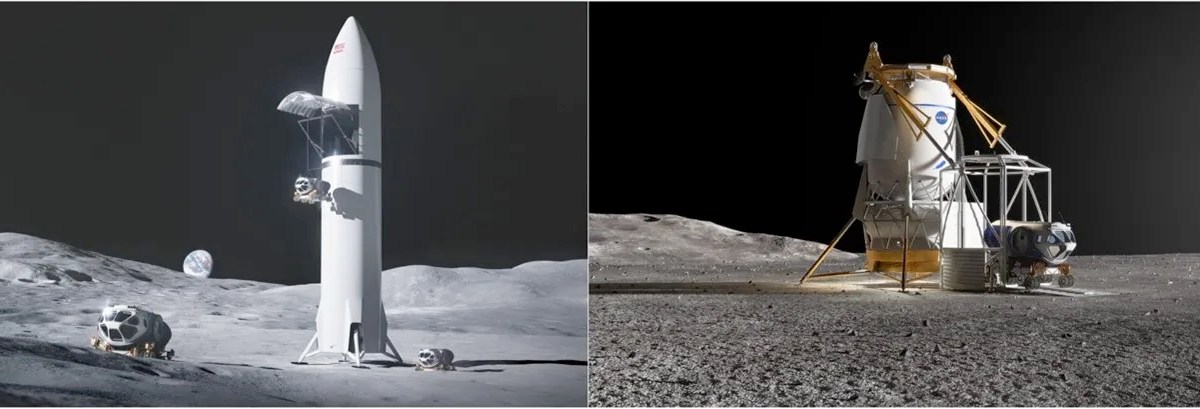NASA’s Ambitious Plans for Lunar Exploration: Utilizing Cargo Versions of Artemis Landers
NASA has unveiled its strategic plan to enhance the exploration of the lunar surface by employing cargo versions of Artemis lunar landers, currently under development by aerospace giants Blue Origin and SpaceX. This initiative involves delivering a pressurized rover and a surface habitat to the moon by the early 2030s, marking a significant step forward in lunar exploration.
NASA’s announcement signifies a critical advancement in lunar logistics, as the agency plans to expand existing contracts with Blue Origin and SpaceX. The goal is to develop cargo versions of Blue Origin’s Blue Moon and SpaceX’s Starship, which are tasked with transporting payloads to the moon’s surface. This marks the first time NASA has awarded such contracts since directing the two companies in January to develop cargo versions of their Human Landing System (HLS) spacecraft.
The collaboration with international partners is also crucial in this endeavor. SpaceX’s Starship is slated to deliver a pressurized rover, developed by the Japanese space agency JAXA, no earlier than fiscal year 2032. This rover will play a pivotal role in exploring and conducting scientific research on the lunar surface. Meanwhile, Blue Origin’s Blue Moon lander is expected to deliver a lunar surface habitat, offering a potential living space for astronauts, by fiscal year 2033.
Lisa Watson-Morgan, NASA’s HLS program manager, highlighted the current progress in design and development for both crewed and cargo landers, as well as the Artemis mission schedules. She noted that NASA has assigned the delivery of the pressurized rover to SpaceX and the lunar habitat delivery to Blue Origin. This strategic decision aligns with NASA’s broader goals of sustainable lunar exploration and development.
While NASA has not disclosed the financial details of the upcoming awards to these companies, the agency plans to issue a request for proposals in early 2025. The rationale behind announcing these planned awards months in advance remains unclear. However, the anticipation of these developments underscores NASA’s commitment to advancing lunar exploration.
The choice of each company for specific cargo missions was not elaborated upon, but NASA emphasized the importance of having two lunar lander providers with distinct approaches for crew and cargo landing capabilities. Steve Creech, NASA’s assistant deputy associate administrator for technical in the Moon to Mars Program Office, expressed that this strategy provides mission flexibility and ensures a regular schedule of moon landings, fostering continuous discovery and scientific opportunities.
This initiative builds upon NASA’s directives from January, when the agency instructed Blue Origin and SpaceX to commence work on cargo versions of their HLS landers. The landers are designed to deliver between 12 to 15 metric tons to the lunar surface, significantly surpassing the capabilities of the robotic landers used in NASA’s ongoing Commercial Lunar Payload Services program, which focuses on delivering science and technology demonstration payloads.
Interestingly, NASA mentioned that the initial work on the cargo versions of Blue Moon and Starship would proceed under existing HLS awards, without the necessity for additional funding. This approach underscores NASA’s efficient allocation of resources to achieve its ambitious lunar goals.
Understanding the Technical Jargon
For those unfamiliar with the technical terms, “Artemis” refers to NASA’s program aiming to return humans to the moon and establish a sustainable presence there by the end of the decade. The “Human Landing System” (HLS) is a critical component of this program, focusing on the development of lunar landers capable of transporting astronauts and cargo to and from the lunar surface.
The “pressurized rover” is a vehicle designed to transport astronauts across the lunar surface while providing a safe, controlled environment. This enables extended exploration missions beyond the immediate landing site. The “surface habitat” refers to a structure designed to house astronauts on the moon, providing them with living quarters and workspaces for extended missions.
The collaboration with international partners, such as JAXA, highlights the global nature of space exploration, where countries join forces to achieve common goals. This partnership not only shares the financial and technical burdens but also fosters a sense of unity in advancing human exploration beyond Earth.
Good to Know: The Bigger Picture
NASA’s Artemis program is part of a broader vision to extend human presence beyond Earth, with an eye towards Mars and other destinations in the solar system. The lessons learned from lunar exploration will be invaluable in planning future missions to Mars, where similar challenges of transportation, habitation, and resource utilization will be encountered.
The use of cargo landers to deliver large payloads to the moon is a vital step in developing the infrastructure needed for sustained human presence. These missions will lay the groundwork for a lunar base, serving as a hub for scientific research, resource extraction, and even potential commercial activities.
Public Reaction and Industry Insights
The announcement of NASA’s plans has been met with enthusiasm from the space exploration community. Industry experts acknowledge the significance of utilizing cargo landers to transport essential equipment and habitats to the lunar surface. This approach not only supports human exploration but also opens up opportunities for scientific research and commercial ventures on the moon.
Space enthusiasts and experts alike are keen to see how the collaboration between NASA, Blue Origin, SpaceX, and international partners unfolds. The success of these missions could pave the way for more ambitious endeavors, such as establishing a permanent human presence on the moon and exploring Mars.
Conclusion
NASA’s decision to use cargo versions of Artemis lunar landers developed by Blue Origin and SpaceX is a critical step in advancing lunar exploration. By delivering a pressurized rover and a surface habitat to the moon, NASA aims to establish a sustainable presence on the lunar surface, fostering scientific discovery and paving the way for future missions to Mars and beyond.
This initiative reflects NASA’s commitment to international collaboration and efficient resource allocation, ensuring that the United States remains at the forefront of space exploration. As we look to the future, the successful implementation of these plans could herald a new era of human exploration, unlocking the mysteries of the moon and beyond.
For more Information, Refer to this article.


































